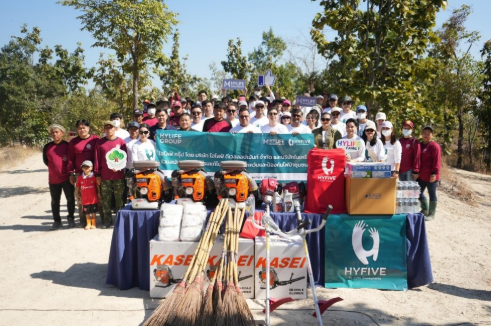Chiang Mai, Thailand’s “Rose of the North,” is known for its rich culture, cool-season charm, and vibrant tourism. Yet, every year, the beauty of the city and surrounding countryside is clouded—literally—by a thick blanket of smog caused by forest fires and agricultural burning. The annual “haze season” often pushes air quality to hazardous levels, threatening public health, tourism, and local livelihoods. Recognizing the urgency of the problem, Mr Shubhodeep Prasanta Das, CEO of HYLIFE GROUP joins in volunteering to build forest firebreak line at Nam Phrae Subdistrict, Hang Dong District, a socially responsible corporate leader, has stepped forward with a strategic blend of community engagement, environmental innovation, and long-term agricultural reform to fight smog and forest fires in the region.
Tackling the Problem at Its Roots
HYLIFE Group understands that forest fires and crop burning are not merely acts of negligence—they are often tied to economic necessity.
To address the root cause, HYLIFE Group launched a Sustainable Crop Management Program, partnering with farmers to introduce alternatives to open burning. The company provides training in composting, mulching, and biochar production, turning agricultural waste into valuable soil enhancers instead of smoke. Additionally, HYLIFE Group has implemented a Supply Chain Traceability System using satellite monitoring to ensure that raw materials, particularly animal feed corn, are sourced from farms that comply with zero-burning policies.
Community Fire Prevention Initiatives
Preventing fires before they start is central to HYLIFE Group’s strategy. Working closely with local administrative bodies, HYLIFE Group organizes annual firebreak construction drives in high-risk forest areas. Equipped with tools, protective gear, and water tanks provided by the company, volunteers—ranging from employees to villagers—clear strips of vegetation that act as barriers to slow the spread of wildfires.
In 2024, HYLIFE Group piloted an innovative “Leaves for Resources” Program in rural Chiang Mai. Residents are encouraged to collect dry leaves and other flammable debris and exchange them for essential goods like rice, eggs, or cooking oil. This initiative not only reduces combustible material on the forest floor but also offers tangible benefits to the community, fostering cooperation and shared responsibility.
Public Awareness and Education
HYLIFE Group recognizes that sustainable change depends on shifting public attitudes toward fire and land management. Through partnerships with local schools, universities, and media outlets, the company sponsors Clean Air Campaigns highlighting the health risks of smog and the environmental cost of forest fires. Educational workshops teach practical methods for waste disposal, soil improvement, and fire prevention, ensuring that knowledge is passed to the next generation.
Collaboration with Stakeholders
HYLIFE Group actively collaborates with government agencies, NGOs, and regional partners. This includes aligning with provincial disaster offices to coordinate fire response, working with environmental research institutes to assess air quality data, and engaging with neighboring provinces to promote cross-border fire prevention measures.
By involving diverse stakeholders, HYLIFE Group helps ensure that policies are practical, culturally sensitive, and backed by real-world community support.
A Vision for a Cleaner Chiang Mai
HYLIFE Group’s fight against smog and forest fires is more than an annual CSR project—it’s a commitment to the health, economy, and cultural heritage of Northern Thailand. By combining technological solutions, community-driven action, and agricultural reform, the company aims to reduce both the frequency and severity of the haze season.
As Chiang Mai looks toward a future where clear blue skies replace seasonal grey, Mr Shubhodeep Das’ work stands as a model of how private enterprise can play a pivotal role in environmental stewardship. Their initiatives show that with innovation, collaboration, and compassion, even the most entrenched environmental challenges can be addressed—one clean breath at a time.




